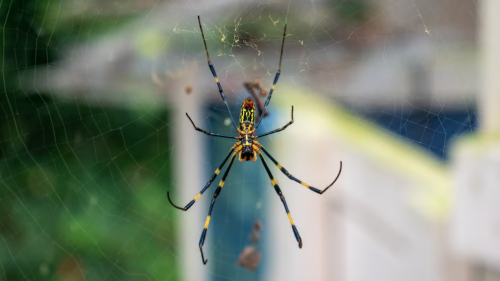
Get ready, Northeastern U.S. — a giant, parachuting spider species might be heading your way. But what exactly are these Joro spiders, and how worried should we be?
Joro spiders, which are currently spreading throughout the southeastern United States, could start appearing in Pennsylvania, New Jersey, and Delaware this summer.
Native to East Asia, these yellow and black arachnids have been established in Georgia for about a decade. A 2023 peer-reviewed study by David Coyle, a scientist and assistant professor at Clemson University, confirmed that the species is “here to stay” in the U.S. as it rapidly expands its range.
As of October 2022, Joro spiders had spread across at least 120,000 square kilometers in Georgia, South Carolina, North Carolina, and Tennessee. There have also been sightings in Alabama, Maryland, Oklahoma, and West Virginia. The spiders are expected to continue their spread, reaching more East Coast states.
Coyle stated, “The data from the study shows that this spider is going to be able to inhabit most of the eastern U.S. Their comfort area in their native range matches up very well with much of North America. Barring some unforeseen circumstance, we expect the range of these things to continue expanding, likely to the north, and we’ve already seen that with some populations in Maryland.”
Joro spiders are light enough to travel by “ballooning,” a process where they release silk threads to catch the wind, allowing them to drift through the air. This makes it easy for them to spread quickly.
Identifying Joro Spiders: Appearance and Safety
Female Joro spiders, scientifically known as Trichonephila clavata, can have bodies about 1 inch long with legs spanning up to 4 inches. They are brightly colored, while the males are brown. Despite their large size, Joro spiders are relatively harmless to humans and pets.
Will Joro Spiders Arrive in the Delaware Valley Soon?
It’s possible, but there’s no need for immediate concern. In their native range, Joro spiders thrive in relatively cold areas, similar to the climate in much of Pennsylvania. According to Penn State, they are likely to spread throughout eastern North America, reaching as far north as Pennsylvania and possibly beyond in warmer coastal areas.
Between 2014 and 2022, Joro spiders spread outward from their initial location by 50–80 miles, or about 10 miles per year. At that rate, they could reach southeastern Pennsylvania in 35 years and northwestern Pennsylvania in 60 years. However, spiderlings are capable of moving tens to hundreds of miles via ballooning. Human-mediated transport also increases the risk of their spread.
State Responses and Expert Opinions
NBC10 reached out to wildlife officials in Pennsylvania, New Jersey, and Delaware. Pennsylvania officials suggested consulting the Penn State Extension for more information. In New Jersey, the Department of Environmental Protection said they are not involved in tracking or researching Joro spiders. Delaware’s Department of Natural Resources and Control recommended contacting the University of Delaware’s Department of Entomology and Wildlife Ecology.
Dr. Doug Tallamy, an entomologist at the University of Delaware, downplayed the threat of a Joro invasion, stating, “It’s possible but very low on the list of things we should be worried about.”
Origins and Behavior of Joro Spiders
Joro spiders are native to East Asia and likely arrived in the U.S. via shipping containers. They belong to the orb-weaver family, known for spinning large, orb-shaped webs similar to garden and banana spiders.
These spiders primarily spread through natural dispersal mechanisms like ballooning. However, human-mediated transport has also contributed to their spread.
Are Joro Spiders Dangerous?
While their large size may seem intimidating, Joro spiders are not dangerous to humans or pets. A study by the University of Georgia found them to be quite shy. They only bite if cornered, and their fangs are usually too small to penetrate human skin.
“Our paper shows that these spiders are really more afraid of you than the reverse,” said Andy Davis, lead author of the study and a research scientist at UGA’s Odum School of Ecology.
Joro spiders prefer to stay outside, spinning webs on the exteriors of homes or other structures. If you need to move one, using a broom or stick should suffice.
What Do Joro Spiders Eat?
Joro spiders are not picky eaters. They consume mosquitoes, yellowjackets, stink bugs, and even spotted lanternflies. According to Coyle, “They don’t seem to care what gets in their web.”
Interestingly, Joro spiders are displacing native species and having other negative impacts, though the reasons are not entirely clear. Coyle explained, “These are not just benign spiders coming to catch and kill bad things; these are pushing out native species and catching and killing whatever happens to get in their webs.”
Disclaimer: The information presented in this article is based on current events and data available at the time of publication to the best of our research and knowledge. It is intended for educational and informational purposes only and should not be construed as professional advice or financial advice or sportsbetting advice or life advice. It is simply our best guess. We at Las Vegas Top Picks do our best to get stories accurate, but sometimes mistakes happen, and it is always good to double-check other sources and media outlets to confirm stories and factual details. The opinions expressed in this article do not necessarily reflect the overall opinion of Las Vegas Top Picks.








